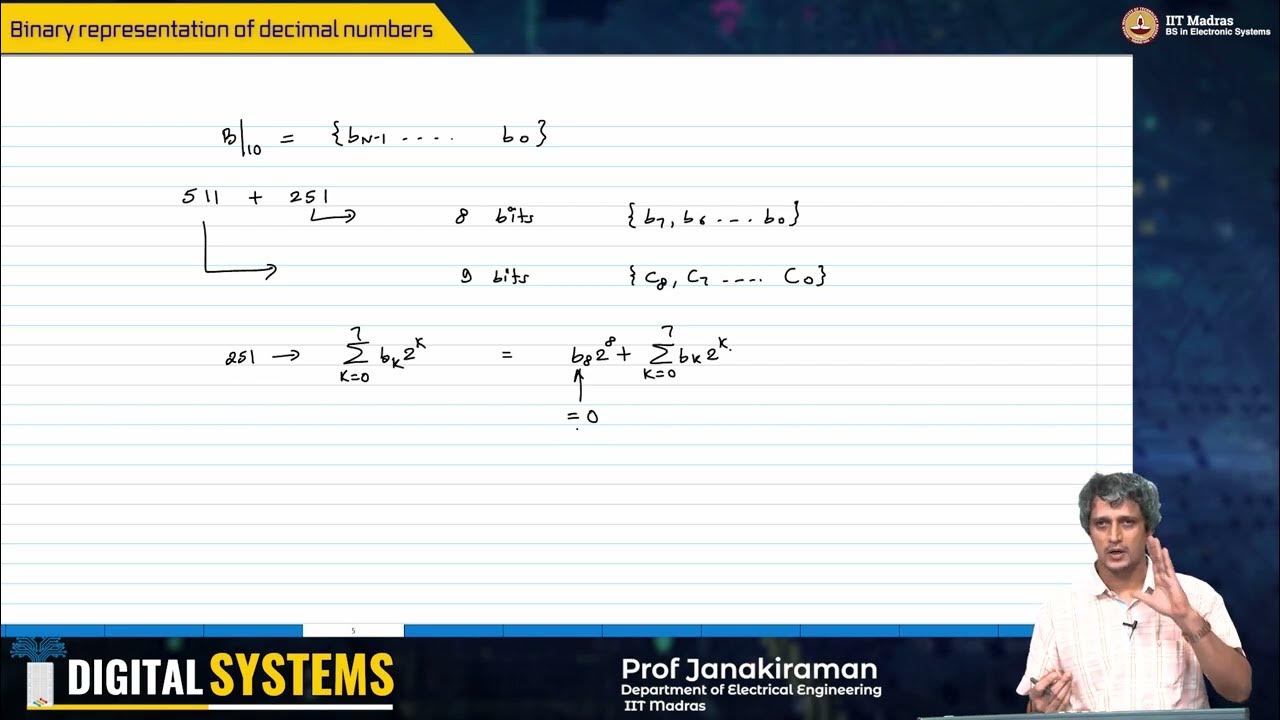How To Convert Binary To Decimal - Computer Science
Summary
TLDRThis educational video script offers a comprehensive guide on converting binary numbers to decimal numbers. It explains the process through various examples, highlighting the significance of powers of two and how to calculate them. The script also delves into converting fractional binary numbers, illustrating the use of negative exponents and their reciprocal values. By the end, viewers are equipped with the knowledge to perform binary to decimal conversions with ease.
Takeaways
- 📚 Converting binary numbers to decimal involves multiplying each binary digit by 2 raised to the power of its position, starting from 0 on the right.
- 🔢 The first digit on the right in a binary number represents 2 to the power of 0, the next represents 2 to the power of 1, and so on.
- ⚠️ Zero values in the binary number can be ignored as they contribute nothing to the sum when multiplied by any power of 2.
- 👉 Focus on the '1's in the binary number as they are the only digits that affect the decimal outcome.
- 💡 Powers of 2 increase exponentially: 2^0 = 1, 2^1 = 2, 2^2 = 4, 2^3 = 8, 2^4 = 16, and so on.
- 🔄 To convert a binary number to decimal, sum the products of each binary digit and its corresponding power of 2.
- 📉 For binary numbers with a fractional part, use negative exponents for digits to the right of the decimal point.
- 🔼 Negative exponents in binary to decimal conversion represent fractions, such as 2^-1 = 0.5, 2^-2 = 0.25, and so forth.
- 📝 Practice is key to mastering binary to decimal conversion, as demonstrated with multiple examples in the script.
- 📖 The script provides a clear method for converting binary numbers, including those with fractional parts, into decimal numbers.
Q & A
What is the process of converting a binary number to a decimal number?
-To convert a binary number to a decimal number, you multiply each digit by 2 raised to the power of its position, starting from the right with 0 and summing up the results.
How do you handle zeros in binary to decimal conversion?
-Zeros in a binary number can be ignored during conversion because multiplying by zero results in zero, which does not affect the sum.
What is the value of 2 to the power of zero in binary to decimal conversion?
-2 to the power of zero is always 1, as any number to the zero power equals 1.
Can you provide an example of converting a binary number to decimal using the script's method?
-Sure, for the binary number 1010, the conversion would be 1*(2^3) + 0*(2^2) + 1*(2^1) + 0*(2^0), which equals 8 + 0 + 2 + 0, resulting in the decimal number 10.
What is the significance of the position of digits in binary to decimal conversion?
-The position of a digit in a binary number determines the exponent to which 2 is raised when converting to decimal. The rightmost position is 0, and it increases as you move left.
How do you convert a binary number with a fractional part to a decimal?
-For binary fractions, you use negative exponents for digits to the right of the decimal point, similar to whole numbers but with positions starting from -1 and decreasing.
What is the decimal equivalent of the binary number 1100.101?
-The binary number 1100.101 converts to decimal as 12.625, calculated by adding 1*(2^3) + 1*(2^2) + 0*(2^1) + 0*(2^0) + 1*(2^-1) + 0*(2^-2) + 1*(2^-3), which equals 8 + 4 + 0.5 + 0.125.
What is the pattern for converting negative exponents in binary to decimal?
-Negative exponents in binary to decimal conversion follow the pattern where 2 to the negative n power is 1 over 2 to the n power.
Can you provide a tip for quickly converting binary numbers to decimal?
-Knowing the powers of 2 up to at least 2^8 (256) can greatly speed up the conversion process, as you can directly associate each binary digit with its decimal equivalent.
What is the decimal result of the binary number 1101.11 after following the script's conversion method?
-Following the script's method, the binary number 1101.11 converts to decimal as 13.75, calculated by 1*(2^3) + 1*(2^2) + 0*(2^1) + 1*(2^0) + 1*(2^-1) + 1*(2^-2), which equals 8 + 4 + 0 + 1 + 0.5 + 0.25.
Outlines

Cette section est réservée aux utilisateurs payants. Améliorez votre compte pour accéder à cette section.
Améliorer maintenantMindmap

Cette section est réservée aux utilisateurs payants. Améliorez votre compte pour accéder à cette section.
Améliorer maintenantKeywords

Cette section est réservée aux utilisateurs payants. Améliorez votre compte pour accéder à cette section.
Améliorer maintenantHighlights

Cette section est réservée aux utilisateurs payants. Améliorez votre compte pour accéder à cette section.
Améliorer maintenantTranscripts

Cette section est réservée aux utilisateurs payants. Améliorez votre compte pour accéder à cette section.
Améliorer maintenantVoir Plus de Vidéos Connexes

W2_L2_Binary representation of decimal numbers

78. OCR A Level (H046-H446) SLR13 - 1.4 Converting between binary, hex & denary

[Part 1] Unit 2.1 - Binary Numbers

CCNA - Converting Between Binary and Decimal Numbering Systems

Konversi Bilangan Biner ke Desimal - Cara Cepat dengan Rumus Tabel Konversi

Addition of Unsigned Binary
5.0 / 5 (0 votes)
